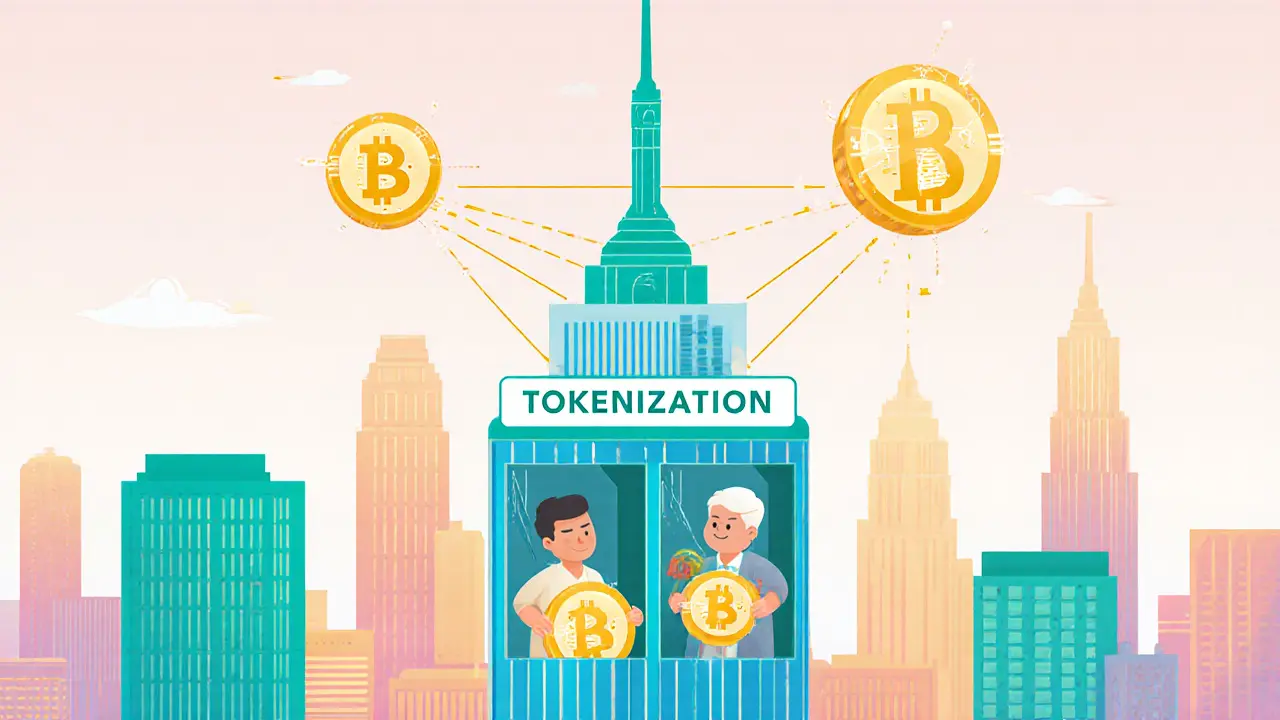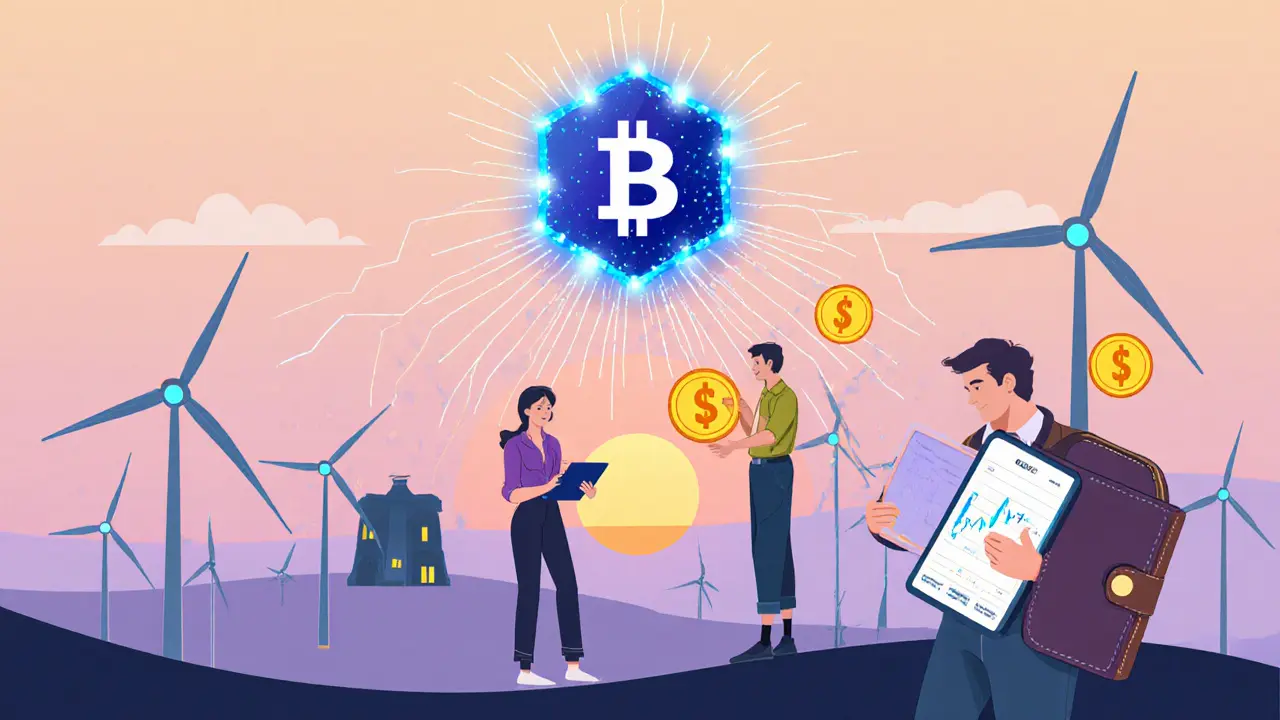RWA Tokenization Platforms: How Real Assets Are Going Digital on Blockchain
 Dec, 20 2024
Dec, 20 2024
RWA Platform Comparison Tool
Find Your Ideal RWA Platform
Select your criteria to see which RWA platforms match your needs. This tool compares key features like fees, timeframes, and compliance requirements.
Matching Platforms
Note: Platform capabilities change rapidly as regulations evolve. Always verify current requirements with the platform directly before investing.
Imagine owning a piece of a Manhattan skyscraper for just $500. Or investing in a wind farm in Germany without needing a lawyer, a bank, or a million dollars. That’s not science fiction-it’s what RWA tokenization platforms are making real today.
Real-World Asset (RWA) tokenization turns physical things-like buildings, machinery, invoices, or even music royalties-into digital tokens on a blockchain. These tokens represent ownership, and they can be bought, sold, or traded like crypto. The big win? You don’t need to own the whole asset anymore. You can own a fraction. And that fraction can be traded 24/7, anywhere in the world, in minutes-not weeks.
But this isn’t just about making investing easier. It’s about fixing broken systems. Traditional finance moves slowly. Buying a commercial property? It takes 45 days to close. Tokenization cuts that to 72 hours. Dividends? Instead of waiting for a check in the mail, they auto-pay to your wallet. Liquidity, which used to be locked up in illiquid assets, is now flowing freely.
How RWA Tokenization Actually Works
It’s not magic. It’s a process-and it’s more legal than technical.
First, you pick an asset. Real estate is the most common. But private credit, machinery, fine art, and even royalty streams from movies or patents are being tokenized too.
Then comes the legal layer. You can’t just slap a token on a building and call it done. You need a Special Purpose Vehicle (SPV)-a legal shell that holds the asset and issues the tokens. This SPV is the bridge between the real world and the blockchain. It ensures that owning a token means you legally own a share of the underlying asset.
Next, the token is minted. Most platforms use Ethereum or Polygon because they’re stable, secure, and support standards like ERC-20. The token isn’t just a number-it’s coded with rules. Who can buy it? Only verified investors. When rent is collected? It auto-divides and sends to token holders. When someone sells? The system checks if they’re still compliant with KYC/AML rules.
Oracles like Chainlink connect the blockchain to real-world data. If the value of the building drops because the neighborhood declines, the oracle feeds that price into the smart contract. That’s how the token’s value stays tied to reality.
Finally, the tokens go on a marketplace. Investors buy them. They trade them. And because it’s on a blockchain, settlement is near-instant. No clearinghouses. No middlemen. Just code.
Who’s Leading the Pack?
Not all RWA platforms are built the same. Some focus on real estate. Others on private credit. Some are built for Wall Street. Others for retail investors.
Securitize, founded in 2017, is the go-to for institutional investors in North America. They work with banks, hedge funds, and even BlackRock. Their platform is designed to plug into existing broker-dealer systems. In January 2024, they tokenized $100 million in U.S. Treasury bonds-a landmark moment for traditional finance embracing blockchain.
MANTRA Chain launched its own Layer 1 blockchain in March 2024, built specifically for RWA. It’s regulatory-first. KYC and AML checks are baked into every token. They dominate in Europe and the Middle East, with 28% market share in those regions. Their platform handles everything from asset structuring to compliance reporting-ideal for asset managers who need to answer to regulators.
Mintology specializes in commercial real estate. Their platform integrates with property management software, so rent collection, maintenance requests, and tenant data sync automatically. That’s huge for real estate operators who don’t want to run two separate systems.
S-PRO is the European specialist. If you’re tokenizing assets in Germany or France, they know the local laws better than most lawyers. They’ve handled everything from solar farms to vintage wine collections.
Each platform has trade-offs. Securitize is the most trusted but least beginner-friendly. MANTRA is the most compliant but costs more. Mintology is great for real estate but weak on other asset classes. S-PRO is deep in Europe but light in the U.S.

Why This Matters-And Why It’s Still Risky
The potential is massive. The Boston Consulting Group says tokenized assets could hit $16 trillion by 2030. That’s not crypto speculation. That’s real estate, bonds, and infrastructure moving onto blockchains.
For everyday investors, it’s a game-changer. You can now diversify into assets that were once only for the ultra-rich. A single token might give you 0.001% of a $100 million office tower. That’s exposure to high-value real estate without the headaches of being a landlord.
But the risks are real.
Regulation is a patchwork. Switzerland has clear rules. Wyoming has crypto-friendly charters. The U.S. federal government? Still figuring it out. A platform that works in Singapore might be illegal in New York. That’s why 65% of institutional users say regulatory uncertainty is their biggest headache.
Liquidity is another issue. While real estate tokens trade decently, tokens for things like machinery or patents? Daily volumes can be under $50,000. That means wide bid-ask spreads-sometimes 8-12%. You might buy at $10 and struggle to sell for more than $9.20.
And then there’s the tech. Smart contracts can have bugs. Oracles can fail. Custody of the actual asset-like a building or a jet engine-still relies on physical trustees. If the custodian goes under, who owns the asset? Insurance for RWA is just starting to emerge, with companies like Nexus Mutual offering coverage, but it’s still niche.

Who’s Using This-and What Are They Saying?
A European private equity firm tokenized €50 million in commercial real estate. Settlement time dropped from 45 days to 72 hours. Great. But they spent €220,000 on legal setup and hired three full-time compliance officers to keep up with changing rules.
On Reddit, retail investors rave about buying $500 shares in Manhattan apartments through RealT. But they also complain: “I bought tokens last year. No one’s buying. I’m stuck.” That’s the liquidity problem in action.
On G2, platforms average 4.2 out of 5 stars. Security? Rated 4.7. Ease of integration with old banking systems? A dismal 3.1. That’s the gap between blockchain innovation and legacy finance.
And the numbers back it up: 73 of the top 100 global asset managers are running RWA pilots. That’s not hype. That’s strategy.
What’s Next?
The ecosystem is maturing fast.
Chainlink’s CCIP 2.0 lets RWA tokens move across blockchains-say, from Ethereum to Polygon-without losing legal status. MANTRA’s new blockchain gives institutions privacy controls they need for sensitive deals. SWIFT, the global payments network, is testing connections to RWA platforms. That could mean sending fiat money and crypto in the same transaction.
Standardization is coming. The International Token Standardization Association released Version 3.0 of its RWA token standard in April 2024. It lists 14 mandatory fields for legal enforceability. That’s a big step toward interoperability.
By 2026, Gartner predicts 10% of Fortune 500 companies will have tokenized at least one asset. But only 35% of those will see real liquidity. That’s the hurdle: turning tokens into something people actually want to trade.
Deloitte says there’s an 85% chance RWA becomes a $10 trillion market by 2030. But it also warns: regulatory friction in 2024-2025 could delay mainstream adoption by two to three years.
So what’s the takeaway? RWA tokenization isn’t a fad. It’s infrastructure. It’s the plumbing for the next generation of finance. The assets are real. The demand is growing. The technology works. But the rules? They’re still being written.
If you’re an investor, it’s an opportunity to get in early on assets that were once off-limits. If you’re a business, it’s a way to unlock capital without selling equity. But if you’re jumping in without understanding compliance, custody, or liquidity risks-you’re not investing. You’re gambling.
The future of finance isn’t just digital. It’s fractional. It’s global. And it’s already here.
What exactly is RWA tokenization?
RWA tokenization is the process of converting ownership rights to physical or traditional financial assets-like real estate, machinery, or invoices-into digital tokens on a blockchain. These tokens represent fractional ownership and can be bought, sold, or traded like cryptocurrency, enabling greater liquidity and access for smaller investors.
How do RWA tokenization platforms make money?
They charge fees at multiple stages: setup fees for legal structuring (often $100K-$300K+), minting fees for creating tokens, transaction fees on trades, and monthly maintenance or compliance fees for institutional clients. Some also take a percentage of asset appreciation or revenue generated by the underlying asset.
Can I invest in RWA tokens as a retail investor?
Yes, but with limits. Platforms like RealT and Mintology allow retail investors to buy tokens for as little as $10-$500 in real estate. However, many platforms restrict access to accredited investors due to securities regulations. Always check the platform’s investor eligibility rules before investing.
Are RWA tokens safe?
The blockchain part is secure-smart contracts and cryptography are robust. But safety depends on the underlying asset and legal structure. If the SPV fails or the custodian mismanages the physical asset, your token may not represent real value. Regulatory uncertainty and illiquid markets also add risk. Insurance products are emerging but still limited.
What’s the difference between RWA tokenization and crypto tokens like Bitcoin?
Bitcoin is a native digital asset with no physical backing. RWA tokens are digital representations of real-world assets-like a building or a loan. Their value is tied to the underlying asset’s performance, not market speculation. RWA tokens are also subject to securities laws, while Bitcoin is generally treated as property or commodity.
Which blockchain is best for RWA tokenization?
Ethereum and Polygon are the most popular due to their mature ecosystems, strong developer support, and compatibility with ERC-20 standards. Ethereum offers security and institutional trust; Polygon offers lower fees and faster transactions. Some platforms, like MANTRA, now use their own Layer 1 blockchains optimized for compliance and privacy.
How long does it take to tokenize an asset?
For institutional clients, the process typically takes 6-9 months. The longest phases are legal structuring (35-40% of time) and regulatory approvals (25-30%). Smaller retail-focused tokenizations (like single properties) can be done in 3-4 months if the legal framework is pre-built.
What happens if the asset backing the token loses value?
The token’s value drops in tandem. For example, if a building’s market value falls due to declining demand, the token price adjusts based on oracle-fed price data. Token holders still own their share of the asset, but its worth decreases. Some platforms use reserve funds or insurance to buffer extreme drops, but this isn’t standard yet.
Amanda Cheyne
November 22, 2025 AT 20:05Anne Jackson
November 23, 2025 AT 03:19Jody Veitch
November 23, 2025 AT 15:34Emily Michaelson
November 24, 2025 AT 18:58David Hardy
November 25, 2025 AT 17:53